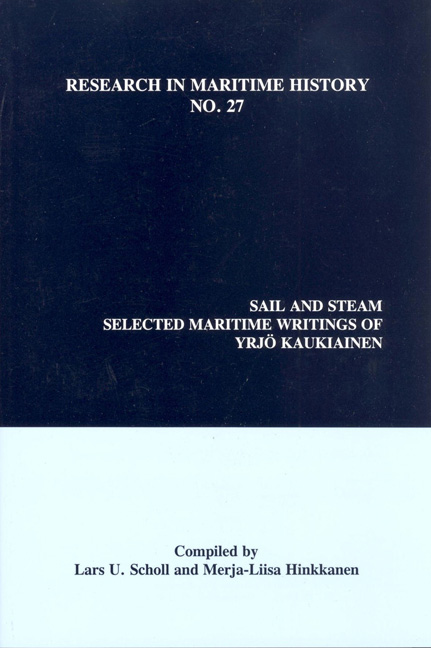Book contents
- Frontmatter
- Frontispiece
- Table of Contents
- Acknowledgements
- “Yrjö Kaukiainen: A Tribute on the Occasion of his Forthcoming Retirement as Professor of Maritime History at the University of Helsinki”
- “Yrjö Kaukiainen: A Man of the Sea”
- “Yrjö Kaukiainen and the Development of Maritime Economic History”
- “Finnish Sailors, 1750-1870”
- “Finnish and International Maritime Labour in the Age of Sail: Was There a Market?”
- “Five Years before the Mast: Observations on the Conditions of Maritime Labour in Finland and Elsewhere”
- “The Maritime Labour Market: Skill and Experience as Factors of Demand and Supply”
- “Owners and Masters: Management and Managerial Skills in the Finnish Ocean-Going Merchant Fleet, c. 1840-1880”
- “From Low-Cost to High-Cost Shipping: Finnish Maritime Labour Costs after the Second World War”
- “The Modernization of Finnish Coastal Shipping and Railway Competition c. 1830-1913”
- “British Timber Imports and Finnish Shipping 1860-1910”
- “Baltic Timber-Trade under Sail: An Example of the Persistence of Old Techniques”
- “Coal and Canvas: Aspects of the Competition between Steam and Sail, c. 1870-1914”
- “Dutch Shipping and the Swedish Navigation Act (1724). A Case Study”
- “Seamen Ashore: Port Visits of Late Nineteenth-Century Finnish Sailors”
- “Wreck-plundering by East Finnish Coastal People - Criminal Tradition or Popular Culture?”
- “From Days and Knots to Pounds and Dollars: Some Problems in the Study of the Economics of Late Nineteenth Century Merchant Shipping”
- “Tons and Tonnages: Ship Measurement and Shipping Statistics, c. 1870-1980”
- “International Freight Markets in the 1830s and 1840s: The Experience of a Major Finnish Shipowner”
- “Shrinking the World: Improvements in the Speed of Information Transmission, c. 1820-1870”
- “Yrjö Kaukiainen: A Maritime Bibliography”
“From Low-Cost to High-Cost Shipping: Finnish Maritime Labour Costs after the Second World War”
- Frontmatter
- Frontispiece
- Table of Contents
- Acknowledgements
- “Yrjö Kaukiainen: A Tribute on the Occasion of his Forthcoming Retirement as Professor of Maritime History at the University of Helsinki”
- “Yrjö Kaukiainen: A Man of the Sea”
- “Yrjö Kaukiainen and the Development of Maritime Economic History”
- “Finnish Sailors, 1750-1870”
- “Finnish and International Maritime Labour in the Age of Sail: Was There a Market?”
- “Five Years before the Mast: Observations on the Conditions of Maritime Labour in Finland and Elsewhere”
- “The Maritime Labour Market: Skill and Experience as Factors of Demand and Supply”
- “Owners and Masters: Management and Managerial Skills in the Finnish Ocean-Going Merchant Fleet, c. 1840-1880”
- “From Low-Cost to High-Cost Shipping: Finnish Maritime Labour Costs after the Second World War”
- “The Modernization of Finnish Coastal Shipping and Railway Competition c. 1830-1913”
- “British Timber Imports and Finnish Shipping 1860-1910”
- “Baltic Timber-Trade under Sail: An Example of the Persistence of Old Techniques”
- “Coal and Canvas: Aspects of the Competition between Steam and Sail, c. 1870-1914”
- “Dutch Shipping and the Swedish Navigation Act (1724). A Case Study”
- “Seamen Ashore: Port Visits of Late Nineteenth-Century Finnish Sailors”
- “Wreck-plundering by East Finnish Coastal People - Criminal Tradition or Popular Culture?”
- “From Days and Knots to Pounds and Dollars: Some Problems in the Study of the Economics of Late Nineteenth Century Merchant Shipping”
- “Tons and Tonnages: Ship Measurement and Shipping Statistics, c. 1870-1980”
- “International Freight Markets in the 1830s and 1840s: The Experience of a Major Finnish Shipowner”
- “Shrinking the World: Improvements in the Speed of Information Transmission, c. 1820-1870”
- “Yrjö Kaukiainen: A Maritime Bibliography”
Summary
One of the most dramatic developments in modern shipping industry has been the decline of many traditional merchant fleets and the growth of tonnage under the so-called “flags of convenience.” Although American ships were registered in Panama already in the 1920s, the trend gained real moment after the Second World War, in particular during the 1970s. Around 1950, only some six percent of global merchant tonnage was on the “convenience” registers while in 1980 the proportion was over thirty percent.
It is clear that shipowners have flagged out vessels for economic reasons. In most developed countries not only safety regulations but also requirements concerning crew's living quarters increase the price of newly-built tonnage as well as running and maintenance costs. Moreover, many national seamen's trade unions have managed to create a “closed-shop” system, which means that only members of the union can be hired on national vessels - and only in accordance with current wage and labour agreements. On the other hand, a vessel flagged out to a convenience register may spare a lot of money in not having to comply with the highest safety standards and, above all, is able to hire seamen from low-wage countries.
In the following I will look into the development of Finnish shipping. As an example of a transition from low-cost to high-cost production it is very interesting. This is mainly because the change seems to have been unusually rapid and extensive. In the 1930s Finland was a low-cost country as far as shipping was concerned. The wages of sailors were low by all international standards, roughly a third of those in Great Britain, lower than in Greece, and only the sailors of the Baltic countries were paid even less. Regulations concerning food provisions and living quarters aboard were, in addition, quite liberal, which of course kept the costs down (it was possible to use old ships with crew quarters which were no more accepted in England). The trade union for seamen was relatively weak, and there were no standards of minimum crew, apart from those for deck and machine officers.
Because of low crew costs Finland was very competitive in shipping. This was more than obvious during the “great depression” when the Finnish merchant tonnage grew considerably in spite of the low level of freights and hard competition.
- Type
- Chapter
- Information
- Sail and SteamSelected Maritime Writings of Yrjö Kaukiainen, pp. 69 - 78Publisher: Liverpool University PressPrint publication year: 2004



